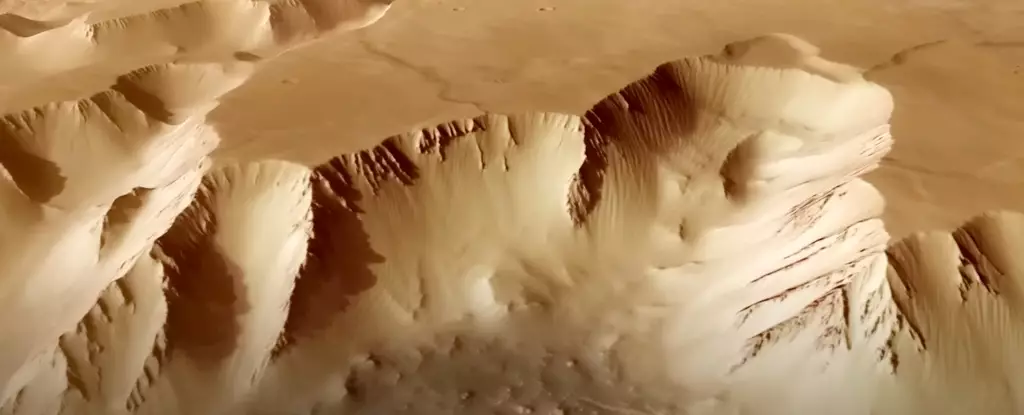Mars has captivated the imaginations of countless individuals, who have dreamt of one day exploring its vast and mysterious landscapes firsthand. While that dream may still be a distant reality, the Mars Express spacecraft has granted us a unique opportunity to glimpse the wonders of the Red Planet through a mesmerizing animation composed of thousands of images. Among the many intriguing regions on Mars, the Noctis Labyrinthus stands out as a particularly captivating area.
The Noctis Labyrinthus, deriving its name from Latin meaning the “Labyrinth of Night,” is located between the dramatic Valles Marineris and the colossal volcanoes of the Tharsis Bulge on Mars. This region encompasses a vast system of valleys spanning an astonishing distance of nearly 1,200 kilometers. Through the combination of images captured by the Mars Express spacecraft, scientists have crafted a breathtaking flyover of this terrain, providing us with a tantalizing glimpse into what future explorers may encounter.
The Noctis Labyrinthus is a shattered landscape that bears witness to the tumultuous history of Mars. The origins of this maze of valleys lie within the Tharsis Rise region, where volcanic activity led to the creation of a bulge, causing the surrounding area to arch upward. As a result, immense tectonic stresses were exerted on the neighboring regions, leading to the thinning of the crust and the formation of structures known as “grabens.” These grabens serve as depressions that settled as the crust stretched and thinned, some reaching staggering depths of up to 5,000 meters.
A Flight Through Time
Embarking on a flight over the Noctis Labyrinthus is not simply a journey through space but also a voyage through time. The highest plateaus depicted in the imagery serve as remnants of the original surface level, allowing us to envision what the area looked like before the extensive tectonic activity and the subsequent erosion that caused portions of the surface to crumble away. While the intersecting canyons and valleys may appear relatively small, they can stretch up to 30 kilometers in width and descend to depths of six kilometers. Millennia of geological processes have sculpted the landscape, leaving behind traces of colossal landslides and vast dune fields formed by the winds that sweep across the Martian surface.
A Cinematic Compilation
The remarkable flyover video of the Noctis Labyrinthus is not the product of a single capture; rather, it is the seamless compilation of numerous individual images. These captivating views were obtained from over eight Mars Express orbits, adding to the richness and depth of the visual experience. To create a three-dimensional landscape, the team combined these images with topographic data derived from a digital terrain model. Every second of the video comprises 50 separate frames meticulously rendered to follow a pre-defined camera path. Additionally, the video pays homage to the history of the Mars Express mission, with the opening credits featuring a Mars globe constructed from a recent 20-year Mars global color mosaic.
Unveiling Mars’ Secrets
Beyond showcasing the awe-inspiring beauty of Mars, this stunning video offers glimpses into the enigmatic history of the planet. By peering into the Noctis Labyrinthus, we gain insight into the earliest geological structures that contribute to the complexity of this captivating Martian terrain. Delving into the intricate fractal patterns and observing the effects of volcanic forces that have shaped the land over millions of years parallels the experience of flying over and through Earth’s Grand Canyon, where cross-cutting fracture zones reveal the deep-seated mysteries of our own planet’s geological past.
As our hunger for knowledge and exploration continues to drive us, the flyover video of the Noctis Labyrinthus serves as a testament to the marvels that await future Marsnauts. Through the lens of the Mars Express spacecraft, we are afforded a glimpse into the mesmerizing and ancient landscapes of the Red Planet. As technology advances and our understanding of Mars deepens, perhaps one day we will find ourselves soaring through the canyons and valleys of Mars, unlocking the secrets it holds and unraveling the enigmatic mysteries of our neighboring planet.


Leave a Reply